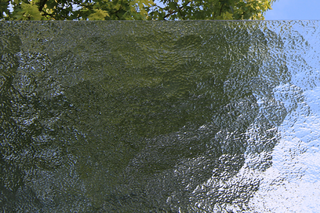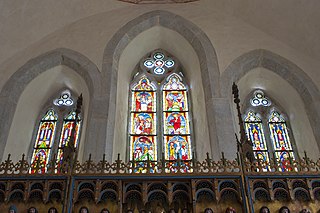Stained glass refers to both coloured glass as a material and to works made from it.
Contents
Stained glass may refer also to:
Stained glass refers to both coloured glass as a material and to works made from it.
Stained glass may refer also to:

Stained glass is colored glass as a material or works created from it. Although, it is traditionally made in flat panels and used as windows, the creations of modern stained glass artists also include three-dimensional structures and sculpture. Modern vernacular usage has often extended the term "stained glass" to include domestic lead light and objets d'art created from foil glasswork exemplified in the famous lamps of Louis Comfort Tiffany.
Judith may refer to:
Enigma may refer to:
Sheep are quadrupedal, ruminant mammals that are typically kept as livestock.
The phrase cloak and dagger describes situations involving intrigue, secrecy, espionage, or mystery.
Glass house or glass houses may refer to:

Cathedral glass is the name given commercially to monochromatic sheet glass. It is thin by comparison with 'slab glass', may be coloured, and is textured on one side. The name draws from the fact that windows of stained glass were a feature of medieval European cathedrals from the 10th century onward.
A pyramid is a structure with triangular lateral surfaces converging to an apex.
Ghost Story or Ghost Stories may refer to:
The lotus-eaters were a race of people in Greek mythology.
Evita may refer to:

Leadlights, leaded lights or leaded windows are decorative windows made of small sections of glass supported in lead cames. The technique of creating windows using glass and lead came to be known as came glasswork. The term 'leadlight' could be used to describe any window in which the glass is supported by lead, but traditionally, a distinction is made between stained glass windows and leadlights; the former is associated with the ornate coloured-glass windows of churches and similar buildings, while the latter is associated with the windows of vernacular architecture and defined by its simplicity.

A revival of the art and craft of stained-glass window manufacture took place in early 19th-century Britain, beginning with an armorial window created by Thomas Willement in 1811–12. The revival led to stained-glass windows becoming such a common and popular form of coloured pictorial representation that many thousands of people, most of whom would never commission or purchase a painting, contributed to the commission and purchase of stained-glass windows for their parish church.

Clayton and Bell was one of the most prolific and proficient British workshops of stained-glass windows during the latter half of the 19th century and early 20th century. The partners were John Richard Clayton (1827–1913) and Alfred Bell (1832–1895). The company was founded in 1855 and continued until 1993. Their windows are found throughout the United Kingdom, in the United States, Canada, Australia and New Zealand.
First Light may refer to:

Medieval stained glass is the colored and painted glass of medieval Europe from the 10th century to the 16th century. For much of this period stained glass windows were the major pictorial art form, particularly in northern France, Germany and England, where windows tended to be larger than in southern Europe. In some countries, such as Sweden and England, only a small number of original stained windows has survived to this day.
White line(s) may refer to:
Level Up may refer to:
Reunion may refer to:

The surviving amount of medieval stained glass in Sweden is relatively small, compared to some other European countries. There are in total 165 medieval stained glass panes with figurative depictions surviving in 37 churches, constituting a total area of about 60 square metres (650 sq ft), a fragment of the original amount but still the largest amount found in any of the Nordic countries. Archaeological evidence and old drawings indicate that many more once existed.